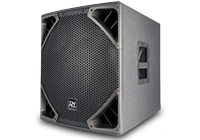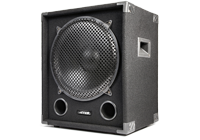Need help? Call our sales team on 0203 326 0900 - we'll be happy to help!
Our PA subwoofer selection is built to provide refined bottom or low-end frequency signals to an existing set of full-range PA speakers. You may have previously heard PA subwoofers in action, with low frequencies emitting their signature rumble or vibration which as a result allows them to be heard with more clarity and from further away. Excellent for use at music venues alongside existing PA speakers, explore your music in more depth with a PA subwoofer.
Buy PA Subwoofers
This type of PA subwoofer is mostly used in nightclubs and other common places of nightlife leisure, with electronic dance music fans swearing by the subwoofer which increases the bass response built into the mix of the audio itself. Human ears generally have issues with hearing erratic frequencies which makes owning a substantial bass bin an excellent choice for DJs and other live artists, helping to fill out their final audio outputs.
A subwoofer helps your final sound feel less tinny, tinny is a common phrase used for music that is compressed either digitally or physically. Tinny refers to the idea that a song sounds like it is being heard through a hollow tin can, if the scope of your music is wider than the capabilities of your existing PA speakers you should look to invest in a bass bin. Bass-heavy music often demands this assistance to get the feel intended by the artist in question.
Your main PA speakers can handle most signals with ease, for example: if a live venue has a solo acoustic act performing, however, some genres of music must be catered for properly. Introducing a passive PA subwoofer or active PA subwooferto your setup alleviates pressure from the top speakers and spreads the signal across a third entity. The speaker drivers are protected by a solid cabinet with a metal grill in front of the cone itself, they also have built-in handles for easier transportation.
Bass Bins
The bass bins we supply are built from strong material that protects the inner loudspeaker from hazards such as spillages etc. The focus on bass is the primary draw to a subwoofer as mentioned, but naturally, as we get older we tend to lose the capability to hear higher frequencies. Bass bins are a great solution to this loss, helping to thicken the sonics above and around 20 hertz to make up for any audio losses, although this more of a personal preference and does not apply equally to everybody.
Bottom signals come from the manipulation of the air within the loudspeaker itself, speakers need to work harder to achieve low signals which is why they are often a fairly large diameter. The rumble or vibration the bass involves the inner loudspeaker moving backwards and forwards to push air around and more importantly towards an audience. The PA subwoofers featured are meant to enhance the live sound at all types of music venues, the speaker driver cones need to be sizeable in this instance and would be quite cumbersome for the typical modern home.
There are other, smaller subwoofer systems to suit home cinema available elsewhere in the store. As mentioned, when linked with a PA system the sub handles the lower signals in the music, allowing the main speakers in your PA setup the relief to focus solely on the higher frequencies. This balanced sound is the key to a refined, professional-sounding initial signal, with the choice to improve it further with a multi-channel audio mixer.
Band Subwoofers
Larger capacity venues will host acts that demand a bigger sound to contend with the space of the room. The use of a band subwoofer is helpful here, again allowing further control of the bass sonics present in the music. If a performer has bass-heavy sound in their synthesisers or bass guitars and kick drums, for example, the sub assists with refining these lower signals to the ear of the sound engineer, who can place them with more accuracy in a professional final mix.
Pertaining to a low band of frequencies is the sole design of the speaker cabinets above and they are built to withstand transport between venues. With a select few sizes to choose from, ensure the sub you choose can be connected to the speakers you already own/plan on purchasing alongside. Select the subwoofer that suits your situation best, even a small sub can pack a punch but do some research to avoid system overload occurring.
A professional sound can only be achieved through balance, too much low or high end will muddy the mix and become unpleasant to listen to. Bass should indeed be tastefully prevalent in your mix, although there is such a thing as too much low end, where the audio becomes distorted and almost unlistenable. Bass is one of the more important factors of music as it creates the stylistic feel of a song, a band subwoofer is designed to accentuate these parts and not push them to the forefront of the audio, balance is key.
What subwoofer has the deepest bass?
Bass can only go so deep, to the point where it becomes almost impossible to ascertain any melodic value to the signal. Subwoofers should instead be judged by how well they augment and accentuate other frequencies in your speaker system as opposed to overshadowing them with deepness.
However, the subwoofers with the deepest bass would be those that are designed in particular for nightclubs, with these subs built for high-powered bass to blast from their woofers. Attendees to these venues will often enjoy a pro sound from a DJ or engineer that knows how to use a sub well. You may have heard an overdriven sub before and are perhaps familiar with the distortion of a subwoofer that is being pushed too far. It is not a pleasant listening experience unless handled in the right way by a professional or somebody in the know.
Frequently Asked Questions
Do I need a subwoofer with PA speakers?
If your speakers are distorting, or if the volume level of your speakers is not quite loud enough, you are definitely in need of a PA subwoofer. By adding a subwoofer to your PA system, the top speakers will be more effective in reproducing midrange and high frequencies, which results in a louder overall sound. The addition of a subwoofer adds bass response while giving your top speakers some breathing room.
What is active subwoofer vs passive subwoofer?
The difference between an active and passive PA subwoofer is their amplification. An active subwoofer has a built-in amplifier and can connect directly to the mains. Passive subwoofers do not have built-in power, so they will need to be connected to an external power amplifier in order to work.
What size subwoofer sounds best?
The size of a PA subwoofer will result in a different range of frequencies. Generally speaking - the larger the woofer driver, the deeper the bass response. That being said, a large subwoofer may not be required for your intended purpose, as a smaller unit is still capable of reproducing extremely deep bass levels with a powerful output.
Can I use a normal speaker as a subwoofer?
PA subwoofers will need to be used with normal full-range speakers, as they are only capable of reproducing bass frequencies. If you are already using standard full-range PA speakers, the only addition you will need for better sound quality and volume levels is a dedicated subwoofer, rather than any additional full-range speakers.
Do subwoofers need to be on the floor?
Yes, it is recommended that you position your PA subwoofer on the floor, as the vibrations being produced will be felt throughout your venue for a more immersive sound experience. Most PA subwoofers are designed to perform optimally on a floor-level surface, rather than mounted like full-range speakers.
How do I choose a subwoofer for my PA system?
It is important to choose the correct PA subwoofer for your system, as some models may not provide any benefit in addition to your existing speaker setup. Consider the driver size and frequency range of a subwoofer when selecting one for your setup, as these will be the determining specifications. For example, if you have a pair of 15” top speakers, a 15” PA subwoofer will not provide much benefit, so it would be better to opt for an 18” model.
How many watts is a good subwoofer?
Contrary to popular belief, the wattage of a PA subwoofer does not correspond to the volume level or sound quality that it is capable of. Wattage is a measurement of power consumption rather than an output rating, so the wattage level of a PA subwoofer should not be a deciding factor when choosing one. Instead, look for the decibel level, sensitivity, and frequency range, as these specifications will be a much more accurate representation of the subwoofer’s capabilities.
What does RMS mean on a subwoofer?
When you see an RMS rating of a PA subwoofer, this is the continuous power handling that it is capable of. The max power rating tells you the highest amount of power that the subwoofer can safely sustain, while the RMS rating is a much more accurate specification that tells you the continuous operating power of a subwoofer.
Can you connect a subwoofer to any speakers?
Most speakers will be able to be used with a subwoofer, but this is achieved in different methods depending on the input and output connections you have available. If you are using active speakers, it is recommended that you connect any audio sources to the PA subwoofer first, and then plugged from the subwoofer’s line output to the active speaker(s) line input. For passive PA speaker systems, the subwoofer will need to be connected to a power amplifier’s line input or output connection, depending on what is available.
Do PA subwoofers need an amp?
An amplifier is required for passive PA subwoofers to work. If you have an active subwoofer, it does not need an amplifier, as it has built-in amplification and can connect directly to mains power. It is important to check your subwoofer model and what additional equipment will be required for it to function properly.
- 2
- 2
- 5
- 8
- 1
- 1
- 1
- 14


